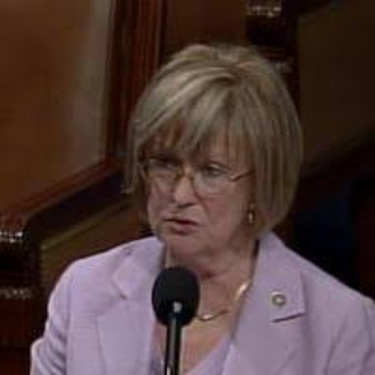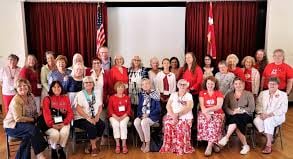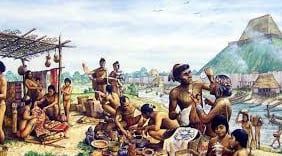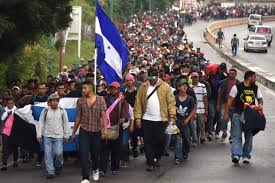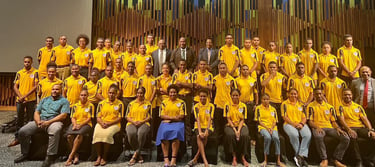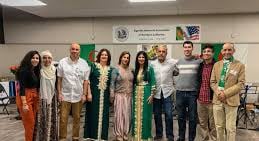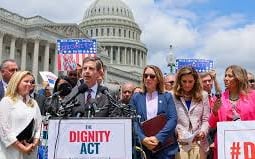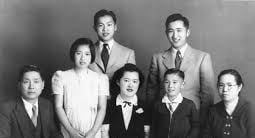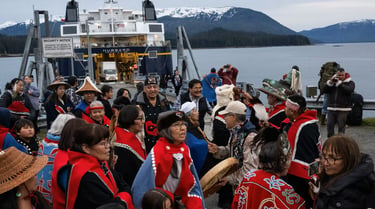Welcome
"Be Aware of The Evils of The Devil - But Learn & Follow The Commandments of Almighty God"
Racial/Cultural/Ethnical Makup of The United States
When the Explorers, Navigators, Conquisitors, Fishermen, Slaves first ventured from the Old World of Europe, Africa and Asia into the New World of North America's present-day United States, there were many nations and tribes of American Indians occupying the territory. Today, the United States Government, recognizes 574-American Indian tribes and Alaska Native entities in the U.S. The first Europeans to reach the mainland of North America (Vineland) in what is now Maryland or Virginia in the United States or lands around the Gulf of St. Lawrence, in Canada., was Viking explorer Leif Eriksson and his party, circa 11-century AD.
The first Hispanic to explore the United States was Spanish Conquistador/explorer Juan Ponce de León's expedition to Florida in 1513. The first Hispanic settlement in the United States was established at St. Augustine, Florida on September 8, 1565, by Pedro Menéndez de Avilés. The first Asian immigration to the United States were Philippine sailors aboard a Spanish galleon who arrived at Morro Bay, California in 1587, and the first Asian settlement was established by Philippine sailors at St. Malo near New Orleans, Louisiana circa. 1763.
The first White European to visit present day United States was Sir Francis Drake, who on June 5, 1579, made landfall at South Cove, Cape Arago, Oregon, and on July 23, 1579, his ship anchored at the Farallon Islands, off the coast of San Francis, California. White European English Captain Christopher Newport of the Virginia Company of London established the colony of Jamestown, Virginia on May 4, 1607.
The first Africans to arrive in the United States were “20 and odd” enslaved African Angolans kidnapped by the Portuguese and sold to the colonists at Jamestown, Virginia on August 20, 1619. The first legally sanctioned free African settlement in the United States was Fort Mose, Florida, established when Spanish Governor Manuel de Montiano ordered its construction in 1738. The Fort was then led by an African escaped slave who had been baptized in the Catholic Church as Francisco Menéndez.
When Alaska became a state on January 3, 1959, the United States recognized the Alaska Natives, which includes the Aleuts, Inupiat, Yuit, Athabascans, Tlingit and Haida. When Hawaii became a state on August 21, 1959, the United States recognized the Native Polynesian Hawaiians (Kānaka Maoli).
Ancient Indigenous Indian Tribe
Pacific Islanders
Europeans
Spanish/Latino/Hispanics
Asians
Japanese Americans Feel They Were Incarcerated Not Interned
Melanesians (Wikipedia), are the indigenous peoples of Western New Guinea in Indonesia and Papua New Guinea, who are commonly called Papuans. In anthropology, "Papuan" is often used to denote the highly diverse aboriginal populations of Melanesia and Wallacea prior to the arrival of Austronesian-speakers, and the dominant genetic traces of these populations in the current ethnic groups of these areas. The origin of Papuans is generally associated with the first settlement of Australasia by a lineage dubbed 'Australasians' or 'Australo-Papuans.' It is estimated that people reached Sahul (the geological continent consisting of Australia and New Guinea), between 50,000 and 37,000 years ago. Rising sea levels separated New Guinea from Australia about 10,000 years ago. However, Aboriginal Australians and Papuans had diverged genetically much earlier, around 40,000 years BC. Papuans are more closely related to Melanesians than to Aboriginal Australians (Wikipedia). Although there are people of Papuan ethnicity living in the United States, their numbers however, are relatively small, as only a small fraction of that population has immigrated to the U.S. According to a Reddit thread, immigration statistics from the Department of Homeland Security (DHS) show that an average of about 20-Papuans obtain U.S. permanent residency each year. Papuan populations in the United States are primarily concentrated in the urban areas of Hawaii and California. There are also smaller communities in Washington, Utah, Nevada, Oregon, Texas, Florida, Arizona, and New York. The Papua New Guinean population (alone or in combination with other races) was one of the fastest-growing NHPI groups in the United States between 2010 and 2020, increasing by nearly 250% to 1,453 Papua New Guineans nationally. As of 2025, Papua New Guinea had sent forty-three science, technology, engineering and mathematics (Stem) students from the country’s six National Schools of Excellence for studies in the United States. Papua New Guinea Education secretary, Dr Uke Kombra said the students were awarded the Stem scholarship by the U.S. Education Department to study in two universities for four years. Dr. Kombra said the program was part of the Papua New Guinea government’s aim to send students overseas for specific courses not available in their country. “The courses are mechanical engineering, bio-chemistry, chemistry, computer and software engineering, petrol energy engineering, molecular and cellular biology, electrical and electronic engineering, civil engineering, agriculture bio-systems engineering and construction engineering in data science” (Study in Papua New Guinea).
Danish Americans (Wikipedia), are people who have ancestral roots originating fully or partially from Denmark. In the 9th and 10th-centuries, the Danish, Swedes and Norwegian Vikings, sailing in their magnificent ships, traveled west to North America, south to the Mediterranean, and east to the Caspian Sea. The Vikings plundered, conquered, traded, and colonized. For a brief period in the 11th-century, a Danish king ruled England and Norway (Every Culture).. Danish immigration to the Americas began in the 1660s, with Denmark's colonization, and arrival to the Virgin Islands, in 1666, of the Danish West India Company. The Danish colonizers brought African slaves to the islands, where the slaves were put to work in the snuff, cotton and sugar industries. These early settlers began to establish trade with New England. In 1728, Danish explorer Vitus Jonassen Bering, working for the Russian empire, documented the narrow body of water that separated North America and Asia, which was later named the Bering Sea in his honor. Danish explorer Bering was the first European to arrive in Alaska in 1741. In the early 17th-century, individual Danish immigrants became established in North America. Scandinavians, Danes and Norwegians in particular, made up a large portion of the settlers in the Dutch colony of New Netherland, now New York. After 1750, Danish families in the Protestant Moravian Brethren denomination immigrated to Pennsylvania, where they settled in the Bethlehem area alongside German Moravians. Danish immigration to the United States in the 1800s was significant, driven primarily by economic hardship and religious freedom. From 1850 to 1860, Mormon missionaries actively recruited converts in Denmark, leading to a significant number of Danish farmers settling in Utah. Most Danes who came to the United States after 1865 did so for economic reasons, as the Danish population in Europe had grown significantly due to advancements in medicine and the food industries, These advancements led to higher poverty rates and an increase in Danish migration. During the 1870s, almost half of all Danish immigrants who settled in the U.S., did so with their families, but by the 1890s, immigration with families accounted for only 25% of the total. Among these Danish immigrants, were those from dairy farming backgrounds. They played a crucial role in developing the American dairy industry, especially in Wisconsin and Iowa (Wikipedia). By 1900, Danish settlements had spread from Wisconsin across northern Illinois and southern Minnesota and into Iowa, Nebraska, and South Dakota. As the midwestern and eastern Great Plains began to fill with settlers, a variety of immigrant leaders and organizations sought to establish Danish agricultural colonies elsewhere by arranging for land companies to restrict sales in specific tracts to Danes. The Danish Folk Society, sponsored several of these colonies. most of which, were quite small and eventually blended into the surrounding community. An exception is Solvang, California, 45 miles north of Santa Barbara, built in 1911, which has become a major tourist attraction and bills itself as "A Quaint Danish Village." The latest wave of immigrants came to the U.S. during the 1950s and the 1960s, when some 25,000 Danish, mostly highly educated young professionals, moved to the United States where they settled in New York, Chicago, Los Angeles, and San Francisco (Every Culture).
Honduran Americans (Wikipedia) are people of full or partial Honduran descent. Hondurans are the eighth largest Hispanic group in the United States and the third largest Central American population. The first Hondurans came to the United Statas during the 18th and 19th-centuries, from a country then known as Intendencia de Comayagua, which in 1820. changed its name to the province of Comayagua, in the Viceroyalty of New Spain (Britannica). The province of Comayagua later gained its independence from the Spanish Crown, founding itself as the republic of Honduras. By beginning of the 20th-century, there was a closer relation between Honduras and the United States, permitting U.S. and Honduran citizens to move from one country to another, due to Honduras' banana companies. Some researchers point out that the start of Hondurans migrating is rooted in U.S. based banana and mining companies such as the Standard Fruit Company and Rosario Mining Company, who some analysts say, transformed Honduras into a kind of U.S. colony similar to Cuba and Puerto Rico during the early 20th-century, where upon, companies exploited many of their workers: In the mid and late 20th-century, constant far-right coups started, and all periods of conflict, specifically the 1956 military coup. In the 1960s, Hondurans immigrated to the United States, primarily to Miami, New York City, and Los Angeles. The main reason for Hondurans to leave their country during that decade was to escape poverty of the rural areas and to escape the military regimes that were against personal freedom. Honduran migration as we know it, started in the late 1980s, when Honduras began to sink into economic and political decline. Other minor Honduran migration was by the Jewish-Hondurans that left the country after the 2009 coup due to the rise of political tension. Many Hondurans migrated legally, and many have joined undocumented Mexican migrants among other Central American people that cross Mexico. in 2018 came the migrant caravan, which started due the Honduran political crisis and the electoral fraud of Juan Orlando Hernández, who was accused of corruption and political repression and the rise of drug cartels. Many Honduran Americans have contributed to American Society through the Arts, Music, and Military Service. Honduran-Americans live in areas with high economic growth and usually seek employment in construction, domestic services, and other industries. Another part of Hondurans create businesses, most commonly, creating local restaurants where traditional food from Honduras can be served. Many Honduran-Americans suffer similar discrimination, as other Hispanic groups, especially Afro-Hondurans (Wikipedia).
Japanese Americans (Wikipedia), are people of Japanese ancestry. However, the Naturalization Act of 1790 restricted naturalized United States citizenship to free white persons, which excluded the Japanese immigrants from citizenship. But people from Japan began migrating to the United Sates in significant numbers following the political, cultural, and social changes stemming from the Meiji Restoration. The Restoration in 1868, were political events restoring practical power to, and consolidating the political system under Meiji, the Emperor of Japan. These early Issei (born in Japan) immigrants came primarily from small towns and rural areas in southern Japanese prefectures, with most of them settling in either Hawaii or along the U.S. West Coast. The Japanese population in the United States grew from 148 in 1880, to 24,326 by 1900. But, due to the Naturalization Act of 1790, the Issei were unable to vote and faced additional restrictions such as the inability to own land under many state laws. In 1907, the Gentlemen's Agreement between the governments of Japan and the United States ended immigration of Japanese unskilled workers, but permitted the immigration of businessmen, students and spouses of Japanese immigrants already in the U.S. Japanese immigration to the U.S. effectively ended when Congress passed the Immigration Act of 1924, which banned all but a few people from Japan. Because no new immigrants from Japan were permitted after 1924, almost all pre-World War II Japanese Americans born after this time were born in the United States. This generation, were the Nisei, (born in U.S.), a distinct cohort from the Issei generation in terms of age, citizenship, and English-language ability. Generational differences, institutional and interpersonal racism led many of the Nisei to marry other Nisei, resulting in a third distinct generation of Japanese Americans, the Sansei. During World War II, an estimated 120,000 Japanese Americans and Japanese nationals or citizens residing on the West Coast of the United States were forcibly interned in ten different camps across the Western United States. The internment was based on the race or ancestry, rather than the activities of the interned. Families, including children, were interned together, and 5,000 were able to "voluntarily" relocate outside the exclusion zone. In 1948, the Evacuation Claims Act provided some Japanese Americans compensation for property losses, but the act required documentation that many former inmates had lost during their removal, and the Act excluded lost opportunities, wages or interest from its calculations. The Civil Liberties Act of 1988 officially acknowledged the "fundamental violations of the basic civil liberties and constitutional rights" of the internment. Many Japanese Americans consider the term internment camp an euphemism and prefer to refer to the forced relocation of Japanese Americans as imprisonment in concentration camps. Significant Japanese immigration had began to reoccur following the Immigration and Nationality Act of 1965, which ended bans against immigration from Japan and other countries. Japanese American culture places great value on education and culture. Across generations, children are often instilled with a strong desire to enter the rigors of higher education. In 1966, sociologist William Petersen, wrote that Japanese Americans "have established this remarkable record, moreover, by their own almost totally unaided effort. Every attempt to hamper their progress resulted only in enhancing their determination to succeed." The 2000 census reported that 40.8% of Japanese Americans held a college degree. In 2023 Japanese Americans had a Median Household Income of $100,611, significantly higher than the Total Population. Japanese Americans also have a very small average household size (2.17), this is in contrast to many other Asian American groups. Japanese Americans have a very high Per Capita Income of $61,568. Japanese American Males have a Median Earning of $86,636 and Japanese Females have a medium earning of $71,468 (Wikipedia).
Immigrant Diasporas & Homes of Eventual Citizens In The United States
United States Policy to Enter Country As Refugee, Migrant, Immigrant, Asylee
Tlingit Angoon Village Celebrate U.S. Navy Apology For 1882 Bombing
Tlingit village in Angoon, Alaska (Wikipedia), is rich with history deeply intertwined with the Tlingit people, who have inhabited the Angoon region for over a thousand years. The Tlingit name for Angoon, "Kootznoowoo," translates to "fortress of brown bears," reflecting the area's abundant wildlife, including a large brown bear population. The village is known as a stronghold of Tlingit culture, with traditions, language, and stories actively preserved and celebrated by its residents. Angoon village is known for its vibrant Tlingit culture, evident in the clan houses, totems, and daily life, particularly through the Raven and Eagle clan system. Human culture with elements related to the Tlingit, originated around 10,000 years ago near the mouths of the Skeena and Nass Rivers. The Tlingit's first contact with Europeans was in 1741 with Russian explorers. Spanish explorers followed in 1775. Tlingits maintained their independence but suffered from epidemics of smallpox and other infectious diseases brought by the Europeans. The 1862 Pacific Northwest smallpox epidemic killed about 60% of the Mainland Tlingit and 37% of the Island Tlingit. The Tlingit culture is multifaceted and complex, characteristic of Northwest Pacific Coast people with access to easily exploited rich resources. In Tlingit culture, heavy emphasis is placed upon family and kinship, and on a rich oratory tradition. Wealth and economic power are important indicators of rank, but so is generosity and proper behavior, all signs of "good breeding" and ties to aristocracy. Art and spirituality are incorporated in nearly all areas of Tlingit culture, with everyday objects such as spoons and storage boxes decorated and imbued with spiritual power and historical beliefs of the Tlingits. Tlingit society is divided into two moieties, the Raven and the Eagle. These in turn are divided into numerous clans, which are subdivided into lineages or house groups. The Tlingits have a matrilineal kinship system, with descent and inheritance passed through the mother's line. Tlingit thought and belief, was historically a fairly well organized philosophical and religious system whose basic axioms shaped the way Tlingit people viewed and interacted with the world around them. Tlingits were traditionally animists. Hunters would ritually purify themselves before hunting animals. Shamans, primarily men, cured diseases, influenced weather, aided in hunting, predicted the future, and protected people against witchcraft. A central tenet of the Tlingit belief system is the reincarnation of both humans and animals (Wikipedia). Angoon village, is a city on Admiralty Island, Alaska. On the 2010 census the population was listed as 459 Tlingit people. In 1878, after the 1867 Alaska Purchase, the North West Trading Company established a trading post and whaling station on nearby Killisnoo Island and employed Angoon villagers to hunt whales. A school, whaling, and a Russian Orthodox church attracted many Tlingits to neighboring Killisnoo. In October 1882, the U.S. Navy bombarded and destroyed the Angoon village. The Navy did not apologize for its actions until 2024. After a short time, the North West Trading Company switched to herring processing. During this time, many Tlingits moved to Killisnoo for employment at the fish plant. In 1928, Killisnoo was destroyed by fire and many Tlingits returned to Angoon. In 1973, Angoon won a $90,000 settlement from the United States government for the 1882 bombardment (Wikipedia).
Federally Recognized Alaskan Natives
To
Honduran Massive Migrant Caravan Walks Toward U.S.
Federally Recognized Indian Tribes & Alaskan Natives
Danish American Culture Formed Around Shared Heritage
Pacific Islanders - Hispanics - Africans - Asians - Europeans - Immigration
Long before the arrival of European explorers, soldiers and settlers in North America, the portion north of Mexico was inhabited by as many as 18-million native people. One settlement, Cahokia Aculturame(Aculturame), in modern-day Illinois, had around 1100-1150 A.D., a population of 20,000 Cahokia people (Wikipedia), at its peak. The settlement of Cahokia had convenient access to the nearby Mississippi River, which its residents, a people known as the Mississippian culture, navigated in large dugout canoes (History)..The Cahokia were an Algonquian-speaking tribe of the Illinois Confederacy (legendsofAmerica), who were usually noted as associated with the Tamaroa tribe. The Cahokia Mounds, a UNESCO World Heritage Site, are the largest pre-Columbian settlement north of Mexico. The Cahokia people who lived there were part of the Mississippian culture, which developed advanced societies across much of the Central and Southeastern United States. The Cahokia Mississippian inhabitants who originally built the mounds experienced the heyday of the city during the 1100s, but by the 1400s, due to depopulation caused by drought, resource scarcity, and climate changes of the time. the Cahokia people were primarily migratory, hunting bison and moving with the changing seasons. Starting around the 1500s, the Cahokia people began to repopulate the Cahokia region. Unlike their previous Mississippian counterparts, the Illinois Confederation populated areas outside of the central city, participating in small-scale agriculture and gardening, and even into smaller groups for hunting and gathering during times of scarcity. The Cahokia and other tribes of the Illinois Confederation faced relocations during the 17th-century, as attacks from other tribes took place. In 1673 when French explorers Louis Jolliet and Jacques Marquette made contact with the region, the Illinois Confederation occupied various corners of the midwest, with the Cahokia and Tamaroa occupying western Illinois and eastern Missouri. The total population of the Illinois Confederation was estimated to be around 10,000. Factors such as warfare from groups such as the Iroquois, and conflicts over resources such as firewood forced many tribes of the Illinois confederation to relocate. Then in 1699, the Cahokia and Tamaroa consolidated and both tribes relocated to Cahokia, Illinois where French missionaries attempted to convert them. In 1752, Shawnee and Meskwaki allies of the British destroyed the primary Cahokia settlement. Survivors joined the neighboring Michigamea. Eventually, the Cahokia, and the Michigamea, were absorbed by the Kaskaskia and finally the Peoria people. By 1752, most of the Cahokia were considered to have left the area. Five Cahokia chiefs and headmen joined those of other Illinois tribes at the 1818 Treaty of Edwardsville (Illinois); they ceded to the United States territory that was half of the size of the present state of Illinois. After the U.S. government implemented its Indian Removal policy in the early 19th century, descendants of the Cahokia were forcefully relocated to Kansas Territory and finally to Indian Territory, present-day Oklahoma. (Wikipedia).
Africans
Beninese American Association of Northern California
Beninese Americans (Wikipedia), are people of Benin descent. Beginning in the first half of the 18th-century to the 19th-century, many slaves were exported from Benin to the United States. During this period, the Kingdom of Benin (National Geographic), was noted for its trade. Tradesmen and artisans from Benin developed relationships with the Portuguese, who sought the kingdom’s artwork, gold, ivory, and pepper. In the late 17th-century to the 18th-century, Benin also became heavily involved in the West African slave trade (The Colonial Williamsburg Foundation). They would capture men, women, and children from rival peoples and sell them into slavery to European and American buyers. This trade provided a significant source of wealth for the kingdom. According to BBC News, King Tegbesu, who reigned in the mid-1700s, is known to have made a significant income from selling people into slavery, estimated to be around £250,000 a year. The number of slaves from Bight of Benin exported to the present United States exceeded 1.6-million captured people with the number of African Americans having one or more Benin ancestors to be very high. It is important to note that slaves from modern Benin, along with Haitian immigrants who arrived in the United States in the late 19th-century, exchanged voodoo practices with Franco-African descendants in Louisiana. The first slaves from Benin to arrive in the U.S., came during the colonial period. Most of the slaves from Benin were imported from Bight of Benin and sent to South Carolina (36%), Virginia (23%), Gulf Coast (28%) and Florida (9,8%). Many slaves were also imported to Louisiana and Alabama by the Clotilda slave ship, whose famous court case testified that the ship took from 110 to 160 slaves from Dahomey to Mobile in 1859. Some of the enslaved people were Cudjo Lewis and Redoshi, considered to be the last persons born on African soil to have been enslaved in the United States when slavery was still lawful in the Gulf Coast. Between 1719 and 1731, most of the slaves who came to Louisiana came directly from Benin, on slave boats such as Duc du Maine. These slaves were enslaved mainly by Spanish settlers, when the Louisiana was under Spanish control. Many of the slaves imported to the United States after Benin was sold by the King of Dahomey, were captured and sold by Dahomey warriors. The captured Benin slaves were brought to the port of Ouidah, where slave shopping took place, and from where some were shipped to the United States. In the 1980s, Benin people began migrating to New York, attracted by educational and employment opportunities. Some Benin immigrants who came to New York, usually worked in manufacture or the sale of African clothing and hair braiding. However, it was not until the 1990s, when the Benin population grew significantly in the U.S. compared to previous Benin immigration to this country. Most immigrants from Benin who came to the U.S., did so seeking better educational and employment opportunities. Many Benin immigrants in the U.S. work more than 80-hours a week with the aim, not only to earn enough money to survive, but also to help their relatives who wanted to emigrate to the United States. Currently, there are Benin communities in cities such as Chicago, Washington, D.C., Philadelphia, and New York (Wikipedia). Note: In the United States, Joshua John Ward is known to have owned the most slaves, with 1,131 recorded in his 1860 will. However, according to the White House Historical Association and Monticello, Thomas Jefferson, the U,S. president, owned more than 600 slaves during his adult life. Jefferson freed two slaves while he lived, and five others were freed after his death, including two of his children from his relationship with his slave Sally Hemings. His other two children with Sally Hemings were allowed to escape without pursuit.
Melanesian Papua New Guinea STEM Students in U.S. to Study
Immigrants & Immigration
Dignity Act of 2025: Addresses Immigration & Immigration Reform
On July 15, 2025, Rep. Maria Elvira Salazar, R-Fla., Rep. Veronica Escobar, D-Texas, and eighteen other House members introduced an updated version of the Dignity Act of 2025. The bill establishes a seven-year deferred action program to grant employment and travel authorization to undocumented residents who have been continuously in the United States since December 31, 2020. Homeland Security estimates there were 10.5 million undocumented immigrants in the U.S. in 2020, and of this group, 84% had lived in the U.S. for more than 10-years. Under the Dignity Act of 2025, participants must pay a $7,000 total in fines in restitution over the seven years of the program. The fines are deposited in the American Worker Fund. The bill establishes a fund with contributions from the Dignity Program, which would manage grants to states and organizations to help U.S. citizens looking for work or transitioning to different careers. The grants would cover apprenticeships, work-based earn-and-learn programs, and educational opportunities for high-demand careers. The bill aims to cover the upskilling costs or to retrain at least one American worker for every participant in the Dignity Program. The Dignity Program requires participants to pay taxes, including taxes owed from previous years; pass a criminal background check, and enroll in health coverage, while barring use of any federal means-tested benefits or entitlement programs. And, individuals must report to DHS every two years. During the duration of the Dignity Act program, participants would need to be gainfully employed or in school for at least four years of the seven years, with limited exceptions. Within 12 months, all noncitizens who are present in the U.S. without lawful status are directed to depart if they do not apply or qualify for the Dignity Program or participate in other alternatives. Those who successfully completes the Dignity Program must apply for Dignity Status. This legal status is renewable every seven years, and individuals can renew the status in perpetuity, as long as they remain in good standing. The Dignity Status does not provide a path to U.S. citizenship, but it allows individuals to stay and continue living in the U.S., while barring use of any federal means-tested benefits or entitlement programs (Immigration Forum). The Dignity Act of 2025, also aims to address border security, asylum procedures, and legal immigration pathways, while establishing American Dream and Promise Act of 2025, a pathway to legal status for Dreamers, and young undocumented immigrants who were brought to the United States as children. Dignity Act of 2025, includes several provisions aimed at bolstering border security. The act authorizes the construction and deployment of physical barriers, tactical infrastructure, and advanced technology along the border. This includes barrier levees, detection technology, roads, and lighting systems to improve situational awareness and operational control. The act mandates a minimum number of flight hours for Air and Marine Operations and ensures the continuous operation of unmanned aerial systems on the border, helping to close the gap between current capabilities and necessary border security measures. The act also establishes a National Border Security Advisory Committee to consult with the Secretary of Homeland Security on border security matters, particularly involving landowners and ranchers in the area.
The Cahokia Indian Tribe of The Midwestern United States
Oji African American Diaspora Blog
Photo: Judy Gail Biggert- American Politician, Attorney & Former United States Representative
"The United States' health care system is the finest in the world, but the country still has too many uninsured Americans, too high prices for prescription drugs, and too many frivolous lawsuits driving physicians out of state or out of business."
Quote: Judy Gail Biggert - American Politician, Attorney & Former United States Representative
People From Africa & Asia Seeking a Better Life
People From Europe & All Migrants/Immigrants Seeking a Better Life
This Blog Site Was Created Using Hostinger
This Blog Site is Online Using AT&T Internet
Oji Okaome, Blog Administraor & Editor
